 Purdue University - Extension - Forestry and Natural Resources
Purdue University - Extension - Forestry and Natural Resources
Got Nature? Blog
The Indiana Natural Resources Teacher Institute (NRTI) is an annual multi-day conservation education workshop and tour of forest management, forest industry and forestry research in Indiana. The purpose of the institute is to provide an introduction to the impact sustainable forestry has on our state’s environment, economy, and quality of life, and to equip teachers to apply that knowledge in the classroom.
The 5-day workshop advances effective teaching and learning about Indiana’s forest resources and their management. Participants will learn how to approach the teaching of STEM (science, technology, engineering and math) concepts and principles from a natural resource perspective through exposure to professionals, researchers, and industry leaders and hands-on experiences in the field. Participants develop a curriculum project to be implemented with their students, bringing natural resource science and management topics and activities into the classroom.

Natural Resources Teacher Institute participants discuss natural resource issues as part of a Project Learning Tree activity session.
Several partners and many sponsors and supporters facilitate this program. The Indiana DNR Division of Forestry Project Learning Tree Coordinator, Lexi Eiler, serves as the lead on this project, and the Division provides housing for the participants at the Morgan Monroe State Forest Training Center. Donna Rogler, the originator of the Indiana NRTI, Lenny Farlee, Purdue Forestry and Natural Resources Extension Forester, and Mary Cutler, Tippecanoe County Parks and Recreation Naturalist, serve as Instructors/facilitators with Lexi for the week of activities and tours. Each of these individuals is also an alumnus of Purdue Forestry and Natural Resources!
Presenters from several agencies, organizations, and companies assist with field tours and presentations, including a tour and activities on the Hardwood Ecosystem Experiment site at Morgan Monroe State Forest. The connection with this long-term, large-scale research project provides a unique STEM application teachers can take back to their classrooms.

Participants experience forest science, forest management, and forest products processing at the Natural Resources Teacher Institute.
The NRTI program can accommodate up to 16 teachers, with emphasis on primary educators, but welcoming to educators from all ages and backgrounds. Many past participants have called this week the best professional development training they have attended. Some comments from our most recent class in June of 2024:
“It was amazing. I am grateful for the activities and all the fantastic materials provided.”
“I learned so much about forestry and forest ecology. I can’t wait to share my lesson with the students.”
“Loved my time at the Indiana Natural Resources Teacher Institute! I learned so much and can’t wait to share and do activities at school this year.”
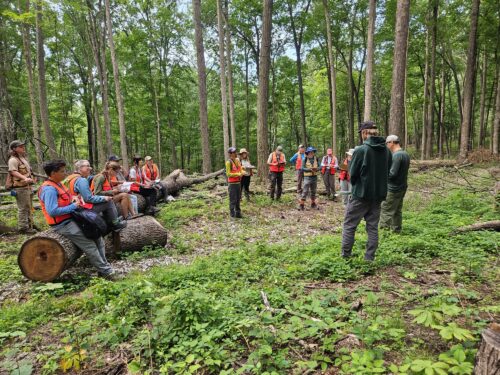
Teachers meet with Indiana DNR foresters to learn about forest management techniques on state forests.
Educators interested in the workshop can visit this DNR website to find out more about schedules and applications – https://www.in.gov/dnr/forestry/programs/education/
Resources:
Purdue Forestry and Natural Resources Facebook Page
Project Learning Tree
Indiana Department of Natural Resources Division of Forestry
The Nature of Teaching, Purdue Department of Forestry and Natural Resources
The Nature of Teaching: Trees of the Midwest, The Education Store
The Nature of Teaching: Adaptations for Aquatic Amphibians, The Education Store
Trees of the Midwest Webinar, Nature of Teaching YouTube channel
Indiana Forestry Educational Foundation, Indiana Forestry & Woodland Owners Association
Forest/Timber, Playlist, Purdue Extension – Forestry and Natural Resources YouTube Channel
Natural Resources Teacher Institute Takes Forestry to the Classroom, Purdue FNR News
Purdue Extension
Lexi Eiler , Coordinator
Indiana Project Learning Tree
Lenny Farlee, Sustaining Hardwood Extension Specialist
Purdue University Department of Forestry and Natural Resources
MyDNR, Indiana’s Outdoor Newsletter: Every May, wild turkey chicks (poults) begin to hatch in Indiana, and DNR needs your help counting turkey broods (hens with poults) and hens without poults.
Brood reports have been collected every year since 1993 to calculate the annual Wild Turkey Production index, which informs biologists about population status and guides management decisions for the species. Please share your 2024 observations with us online from July 1 until Aug. 31. Recording observations takes less than five minutes, and no login is required.
In 2023, DNR received more than 2,203 reports across all 92 counties in Indiana, and we’re hoping for even more this year. Our goal is to receive 3,000 total observations with at least 25 per county.
Why count turkeys?
Brood surveys provide useful estimates about annual production by wild turkey hens and the survival of poults (young turkeys) through the summer brood-rearing period. Summer brood survival is generally the primary factor influencing wild turkey population trends. Information on summer brood survival is essential for sound turkey management. Information gathered through the brood survey includes:
- Average brood sizes (hens + poults). For example, in the photo above there is one hen with seven poults, for a brood size of eight.
- Percentage of adult hens with poults.
- Production Index (PI) = total number of poults/total number of adult hens
What is a wild turkey brood?
A wild turkey brood is composed of at least one adult hen with young (poults). As the summer progresses, multiple broods may gather into what is termed a “gang” brood with several adult hens and multiple broods of poults of varied ages. During summer, adult gobblers (male turkeys) play no role in raising a brood and either form small male only “bachelor” flocks or are observed as a single gobbler.
The Indiana Department of Natural Resources – Department of Fish and Wildlife rely on your observations to calculate their Production Index, so every report counts! Indiana DNR appreciates your participation.
Jarred Brooke, extension wildlife specialist with Purdue Forestry & Natural Resources, shares how you can participate in the Indiana Department of Natural Resources’ annual turkey brood survey in a quick video.
To learn more, visit DNR: Turkey Brood Reporting.
To subscribe to the newsletter visit MyDNR Email Newsletter.
Resources:
Four Simple Steps, Help Indiana DNR Estimate Wild Turkey Populations, Purdue Extension – Forestry & Natural Resources
Truths and Myths about Wild Turkey, The Education Store, Purdue Extension resource center
Wildlife, Playlist, Purdue Extension – Forestry and Natural Resources YouTube Channel
Forest Improvement Handbook, The Education Store
Turkey Brood Reporting, Indiana Department of Natural Resources (IDNR)
Wild Turkey, Indiana Department of Natural Resources (IDNR)
Wild Turkey Hunting Biology and Management, Indian Department of Natural Resources (IDNR)
Subscribe to Purdue Extension-Forestry & Natural Resources YouTube Channel, Wildlife Playlist
Indiana Department of Natural Resources
Illinois-Indiana Sea Grant (IISG) has recently added to its YouTube Channel new water safety videos, which share what to watch for and how to stay out of those scary situations that can become dangerous very quickly.
Water Safety Basics: Water safety is more then just knowing how to swim. You need to what can cause hazards, what type of water bodies have hazards and how to avoid or survive those hazards.
Water Safety – What to Know Before You Go to the Beach: On average every year, 87 people die in the Great Lakes, half of them are in Lake Michigan. Ocean waves are very different from Great Lake waves.
Water Safety – Winter Beach Hazards: Water safety is so important during the winter. When covered in snow and ice, it’s difficult to tell where the beach ends and the lake begins. Shelf ice is beautiful but dangerous. There are many places where it cannot support a person’s weight, which may cause a fall into freezing water below, so you should never walk on shelf ice.
Water Safety – How to Escape Dangerous Currents: Of the five Great Lakes, Lake Michigan has the highest number of drownings and rescues each year. Lake Michigan is freshwater. This is so different from an ocean. It doesn’t have the salt, so it is lacking that buoyancy already. If waves get super high and rip currents start to form and that water gets volatile, it is going to be much harder to get out of the situation if you start struggling while you are swimming.
Water Safety – Southern Lake Michigan: Lake Michigan has also had more than 250 recorded cases of swimmers caught in rip currents since 2002, which is double the combined total of the other four Great Lakes. Make sure you check the forecast before you come and have a safety plan. In the ocean you can get hit by two waves in 15 seconds but in the Great Lakes you could get his with five waves in that same time period. Learn more about high frequency waves and how dangerous it can be.
Illinois-Indiana Sea Grant combines research, education, and outreach to empower southern Lake Michigan communities to secure a healthy environment and economy. The program is funded through National Oceanic and Atmospheric Administration (NOAA) via the National Sea Grant College Program, as well as the University of Illinois and Purdue University. IISG also works in partnerships with key organizations, institutions, and agencies in the region to reach more audiences and multiply opportunities for success. IISG brings together scientists, educators, policy makers, community decision makers, outreach specialists, business leaders, and the general public to work towards a healthy environment and economy.
Subscribe to the Illinois-Indiana Sea Grant (IISG) YouTube Channel.
More Resources:
Implementation Examples of Smart Growth Strategies in Indiana, The Education Store, Purdue Extension’s resource center
Conservation Through Community Leadership, The Education Store
Conservation Through Community Leadership, Sustainable Communities Extension Program (SCEP)
Conservation through Community Leadership, Purdue Extension You Tube Channel
Rainscaping Education Program, Purdue Extension
Rainscaping and Rain Gardens, Purdue Extension YouTube Channel
Tipping Point Planner, The Education Store
Tipping Point Planner, Purdue Agriculture YouTube Channel
Enhancing the Value of Public Spaces, The Education Store
Enhancing the Value of Public Spaces: Creating Healthy Communities, The Education Store
Enhancing the Value of Public Spaces Program, Purdue Extension YouTube Channel
One Water Approach to Water Resources Management, The Education Store
Community Development, Purdue Extension
Community Planning Playlist, Purdue Extension-Forestry & Natural Resources (FNR) YouTube Channel
Indiana Creek Watershed Project – Keys to Success, Partnerships and People, Subscribe to Purdue Extension-FNR YouTube Channel
Climate Change and Sustainable Development, The Education Store
Climate Change: Are you preparing for it?, The Education Store
Diana Evans, Extension & Web Communications Specialist
Purdue University Department of Forestry and Natural Resources
Illinois-Indiana Sea Grant Newsroom: The U.S. Department of State and the Fulbright Foreign Scholarship Board announced earlier this year that Kwamena Quagrainie of Purdue University received a Fulbright Specialist Program award. Through April and May of 2023, Dr. Quagrainie completed a project at Kwame Nkrumah University of Science and Technology, training faculty and graduate students about the economics of aquaculture. The project’s aim was to exchange knowledge and establish partnerships benefiting participants, institutions, and communities both in the U.S. and overseas through a variety of educational and training activities within the field of agriculture.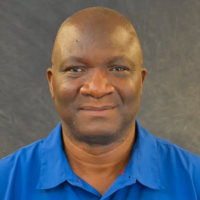
Dr. Quagrainie is one of over 400 U.S. citizens who share expertise with host institutions abroad through the Fulbright Specialist Program each year. Recipients of Fulbright Specialist awards are selected on the basis of academic and professional achievement, demonstrated leadership in their field, and their potential to foster long-term cooperations between institutions in the U.S. and abroad.
The Fulbright Program is the flagship international educational exchange program sponsored by the U.S. government and is designed to build lasting connections between the people of the United States and the people of other countries. The Fulbright Program is funded through an annual appropriation made by the U.S. Congress to the U.S. Department of State. Participating governments and host institutions, corporations, and foundations around the world also provide direct and indirect support to the Program, which operates in over 160 countries worldwide.
For full article and videos please visit Kwamena Quagrainie receives Fulbright Specialist award to Ghana – IISG
Resources
A Guide to Marketing for Small-Scale Aquaculture Producers, The Education Store
A Guide to Small-Scale Fish Processing Using Local Kitchen Facilities, The Education Store
Marine Shrimp Biofloc Systems: Basic Management Practices, The Education Store
Aquaculture Industry in Indiana Growing, Purdue Today
Walleye Farmed Fish Fact Sheet: A Guide for Seafood Consumers, The Education Store, Purdue Extension resource center
Sustainable Aquaculture: What does it mean to you?, The Education Store
The Benefits of Seafood Consumption The Education Store, Purdue Extension Resource Center
Walleye Farmed Fish Fact Sheet: A Guide for Seafood Consumers, The Education Store, Purdue Extension resource center
Pond and Wildlife Management website, Purdue Extension
Fish Cleaning with Purdue Extension County Extension Director, Got Nature? Blog, Purdue Extension – Forestry and Natural Resources
Aquatics & Fisheries, Playlist, Purdue Extension – Forestry and Natural Resources
Eat Midwest Fish, Illinois-Indiana Sea Grant online resource hub
Illinois-Indiana Sea Grant (IISG)
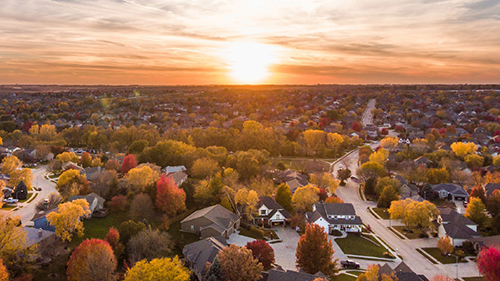 Purdue Extension is launching the Purdue Broadband Team (PBT) to harness the power of Indiana’s land-grant institution to help expand broadband access, adoption, and use as an essential catalyst for economic growth in the state. The Purdue Extension PBT is part a collaborative effort between Purdue, the Indiana Broadband Office, and the Indiana Office of Community and Rural Affairs. Coordinated by Purdue’s Office of Engagement, the Purdue Broadband Team will include Purdue Extension, 4-H, the Purdue Center for Regional Development and the Purdue for Life Foundation. View Purdue News – Purdue launches broadband team, effort to increase high-speed internet access, adoption and use throughout Indiana.
Purdue Extension is launching the Purdue Broadband Team (PBT) to harness the power of Indiana’s land-grant institution to help expand broadband access, adoption, and use as an essential catalyst for economic growth in the state. The Purdue Extension PBT is part a collaborative effort between Purdue, the Indiana Broadband Office, and the Indiana Office of Community and Rural Affairs. Coordinated by Purdue’s Office of Engagement, the Purdue Broadband Team will include Purdue Extension, 4-H, the Purdue Center for Regional Development and the Purdue for Life Foundation. View Purdue News – Purdue launches broadband team, effort to increase high-speed internet access, adoption and use throughout Indiana.
“The lack of affordable high-speed broadband affects economic development and quality of life in various communities in our state,” Purdue President Mung Chiang said. “Continuing our long-standing tradition as Indiana’s land-grant institution, Purdue is honored to play a small and hopefully useful role as the state government plans the next-level broadband deployment.”
Why PBT?
The federal government, in partnership with states, is deploying broadband funds through the Broadband Equity, Adoption, and Deployment program, also known as BEAD. Indiana is receiving close to $870 million starting mid to late 2024. A map put together by the Federal Communications Commission or FCC, the government entity that regulates telecommunications, will dictate where these funds go.
So, PBT needs to make sure Indiana’s broadband map is as accurate as possible.
The PBT will help by spreading the word on resources that will make Indiana’s broadband map more accurate and help with broadband adoption which includes:
- Validating your address and internet service available on the FCC map
- Applying for the Indiana Connectivity Program or ICP
- Conducting speed tests or reporting a lack of connectivity at your address
- Learning more about the Affordable Connectivity Program or ACP
To learn more about the PBT and how you can get involved, along with how to test your internet connection, view the : Purdue Broadband Team website.
Resources:
The Time for Broadband is Now – Purdue University is Playing its Part, Purdue Extension News
Thinking Broadly About Broadband, Purdue Extension News
Purdue Extension Community Development, programs include: Digital Ready Business; Digital Ready Community; Remote Work Certificate Program; Essential Digital Employability Skills Program; and much more.
Broadband, Purdue Center for Regional Development
Connecting Indiana: Broadband for the Future is Now, Purdue Center for Regional Development
Diana Evans, Extension & Web Communications Specialist
Purdue University Department of Forestry and Natural Resources
Wild Bulletin, Indiana Department of Natural Resources (DNR) Fish and Wildlife: Your contributions to the 2023 Turkey Brood Survey surpassed the goal of 3,000 observations. Between July 1-Aug. 31, you contributed a whopping 3,639 observations of wild turkey hens with or without poults. Thank you!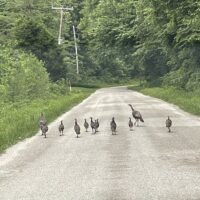
After DNR Division of Fish & Wildlife biologists removed duplicates and reports without exact locations, 2,203 brood observations are being factored into regional production estimates.
Because of your help, we can continue to track population trends and make important management decisions to foster healthy ecosystems in Indiana.
Why count turkeys?
Brood surveys provide useful estimates about annual production by wild turkey hens and the survival of poults (young turkeys) through the summer brood-rearing period. Summer brood survival is generally the primary factor influencing wild turkey population trends. Information on summer brood survival is essential for sound turkey management. Information gathered through the brood survey includes:
- Average brood sizes (hens + poults). For example, in the photo above there is one hen with seven poults, for a brood size of eight.
- Percentage of adult hens with poults.
- Production Index (PI) = total number of poults/total number of adult hens
What is a wild turkey brood?
A wild turkey brood is composed of at least one adult hen with young (poults). As the summer progresses, multiple broods may gather into what is termed a “gang” brood with several adult hens and multiple broods of poults of varied ages. During summer, adult gobblers (male turkeys) play no role in raising a brood and either form small male only “bachelor” flocks or are observed as a single gobbler.
To learn more please visit DNR: Turkey Brood Reporting.
Resources
Truths and Myths about Wild Turkey, The Education Store, Purdue Extension resource center
Wildlife, Playlist, Purdue Extension – Forestry and Natural Resources (FNR) YouTube Channel
Managing Your Property for Fish & Wildlife, Ask an Expert. FNR YouTube Channel
Forest Improvement Handbook, The Education Store
Help With Wild Turkey Populations, Video, Purdue Extension – Forestry and Natural Resources YouTube Channel
Turkey Brood Reporting, Indiana Department of Natural Resources (IN DNR)
Wild Turkey, Indiana Department of Natural Resources (IN DNR)
Wild Turkey Hunting Biology and Management, Indian Department of Natural Resources (IN DNR)
Subscribe to Purdue Extension-Forestry & Natural Resources YouTube Channel, Wildlife Playlist
Indiana Department of Natural Resources
Illinois-Indiana Sea Grant Newsroom: The 2023 issue of Illinois-Indiana Sea Grant’s magazine, The Helm, is now available. This annual publication is a collection of program research, outreach and education success stories as well as ongoing activities to address coastal concerns. This issue is focused on stormwater management with green infrastructure, PFAS, and more, including how students are learning about water quality through hands-on opportunities.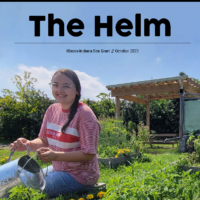
Here are some headlines from this issue:
- Green infrastructure helps communities—large and small—be ready for the future
- With a Hydrolab, Students study their own environment
- Study finds PFAS in all tested Lake Michigan sportfish and their prey
- Aquaponics offers high schoolers a hands-on way to learn science, math, and more
For full article and videos please visit New issue of IISG’s The Helm highlights green infrastructure projects – IISG
To download this new issue please visit IISG’s Publications and Products.
Resources
Aquaculture Industry in Indiana Growing, Purdue Today
Walleye Farmed Fish Fact Sheet: A Guide for Seafood Consumers, The Education Store, Purdue Extension resource center
Sustainable Aquaculture: What does it mean to you?, The Education Store
Pond and Wildlife Management website, Purdue Extension
Fish University Podcasts, NR University, Collaboration with Mississippi, Florida, Iowa and Indiana Extension Services
Fish Cleaning with Purdue Extension County Extension Director, Got Nature? Blog, Purdue Extension – Forestry and Natural Resources
Aquatics & Fisheries, Playlist, Purdue Extension – Forestry and Natural Resources
Eat Midwest Fish, Illinois-Indiana Sea Grant online resource hub
Ask An Expert: Hot and Cold, Video, Purdue Extension – Forestry and Natural Resources YouTube channel
Informing the Development of the Great Lakes Region Decision Support System, The Education Store, Purdue Extension’s resource center
Improving Water Quality Around Your Farm, The Education Store
Scientists bring the Great Lakes to students learning from home, Got Nature? Blog
Adaptations for Aquatic Amphibians Activity 2: Water Quality Sneak Peak, Purdue Nature of Teaching
Illinois-Indiana Sea Grant (IISG)
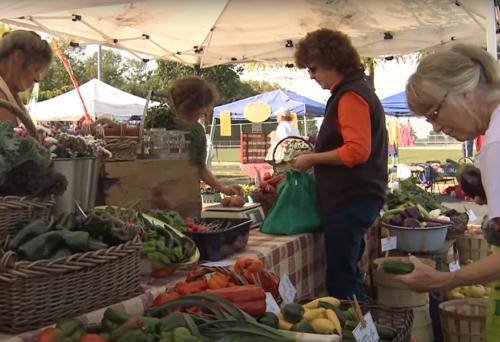 Purdue Extension Showcase, Purdue Extension Annual Report highlights Purdue Extension-Enhancing the Value of Public Spaces program: In Indiana, community leaders make decisions about public spaces such as parks, trails, and schools every day – decisions that affect the health and wellness of communities.
Purdue Extension Showcase, Purdue Extension Annual Report highlights Purdue Extension-Enhancing the Value of Public Spaces program: In Indiana, community leaders make decisions about public spaces such as parks, trails, and schools every day – decisions that affect the health and wellness of communities.
Purdue Extension’s Enhancing the Value of Public Spaces: Creating Healthy Communities program coaches communities through development of high quality action plans for public spaces, guiding decisions and better positioning communities to take advantage of opportunities to promote healthy eating and active living. The curriculum is designed for decision-makers and local leaders who have oversight and management of community public spaces, such as parks boards and plan commissions, public officials and their staff, and members of organizations whose missions relate to services, programs, or management of public spaces.
The program combines data collection and analysis with inclusive public deliberation to design action plans toward meaningful, sustainable improvements of public spaces focused on community health. The goal is to strategically guide policy, systems, and environmental changes to promote healthy communities.
Focusing on Blackford County, a series of online and in-person public participation workshops were conducted to gather residents’ input for the parks and recreation five-year master plan. Three visioning workshops – each two hours long – allowed community members to share assets and opportunities for placemaking, active living, and healthy eating. Podcasts and videos were provided, helping residents understand the conceptual framework. At the first visioning session, participants compiled assets and opportunities, and then voted on themes they felt needed to be the focus of the next two workshops. During the second visioning virtual session, participants focused on placemaking, active living, and healthy eating. In the third session, participants prioritized strategies. At the final session, also two hours, participants completed an action plan for each strategy for placemaking, active living, and healthy eating. In addition, a public survey was conducted to gather input from community residents who could not attend the sessions. Survey results, community data, and the action plan were presented to the community in a 62-page report.
There were 46 virtual participant surveys and 279 public surveys received. Demographics of survey respondents (n=182) were: 94% White, 69% female, and 44% age 25-44. A third (34%) reported they earned less than $50,000 annually, and 25% had attended some college but did not earn a degree. A post-program evaluation was completed by 26 participants (57%). Over 95% found the program informative, felt engaged in activities, and had meaningful discussions. Participants indicated significant takeaways were the concept of community capital, involvement is key, and the realization that there are resources and organizations in the county that can be partners for healthy living. Several mentioned takeaways were working together, communication, and that the program was a catalyst for progress.
Action strategies developed have seen progress since the plan was delivered. To expand and market community events in the parks and create outdoor movie nights downtown, Purdue Extension partnered with Taylor University Social Work Department, Hartford City, Firefly Children and Family Alliance, and Meridian Services to host a community movie night with a mental health awareness theme. More than 70 people attended. Resources, including a newly published community directory, were shared. To develop youth leadership opportunities for parks and public spaces, local students were asked what they would like to see in the community. Twelve high school students identified improvements to a basketball court, and asked for support from Purdue Extension to connect them with local funders. Students raised $1,700 through a Change War competition at school, and a pitch to the plant manager and human resource director at the local 3M factory resulted in an additional $1,600; new goals will be installed. As a result of this effort, a Mayor’s Youth Council will be started to focus on project-based efforts. Purdue Extension’s Enhancing the Value of Public Spaces: Creating Healthy Communities helped communities prepare public spaces action plans to boost economic development, improve the quality of life, and create a healthier place for individuals and families.
To read full article and others, check out Purdue Extension Showcase 2023.
Resources:
Community Development, Purdue Extension
Enhancing the Value of Public Spaces Program Video, Purdue Extension
Enhancing the Value of Public Spaces: Creating Healthy Communities, The Education Store – Purdue Extension’s resource center
Enhancing the Value of Public Spaces Curriculum, The Education Store
Sustainable Communities Extension Program Website, Purdue Extension
Conservation Through Community Leadership, The Education Store
Rainscaping Education Program, Purdue Extension
Subscribe to Purdue Extension – Forestry and Natural Resources YouTube Channel
Kara Salazar, Sustainable Communities Extension Specialist
Purdue University Department of Forestry and Natural Resources
We all want clean water but sometimes it is hard to know how one individual or family can make a difference. People who have a home with a yard have the opportunity to make decisions that can protect and improve water quality.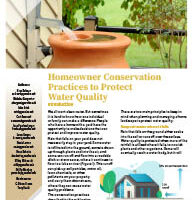
Rain that falls on your yard does not necessarily stay in your yard. Some water is infiltrated into the ground, some is drawn up through plants and into the air, and some can run off and flow into a roadside ditch or storm sewer, where it continues to flow to a lake or river. This runoff can pick up soil particles, motor oil, lawn chemicals, or other pollutants on your property and carry them downstream, where they can cause water quality problems.
Anyone who has a home with a yard can help protect and improve water quality. This publication offers practical advice about reducing impervious surfaces, select proper landscape plants, effective management of lawns, installing rain barrels and rain gardens, and proper care of septic systems.
To receive the free download visit the Purdue Extension’s resource center: The Education Store – Homeowner Conservation Practices to Protect Water Quality.
Resources:
Improving Water Quality by Protecting Sinkholes on Your Property, The Education Store, Purdue Extension’s resource center
A Landowner’s Guide to Sustainable Forestry: Part 5: Forests and Water, The Education Store
Improving Water Quality Around Your Farm, The Education Store, YouTube
Animal Agriculture’s Effect on Water Quality: Pastures and Feedlots, The Education Store
Improving Water Quality At Your Livestock Operation, The Education Store, YouTube
The Nature of Teaching: Discovering the Watershed, Purdue Extension-The Nature of Teaching
Rainscaping Education Program, Purdue Extension
Community Planning, Purdue Extension
Kara Salazar, Assistant Program Leader and Extension Specialist for Sustainable Communities
Purdue Department of Forestry and Natural Resources
Nick Burgmeier, Research Biologist and Wildlife Extension Specialist
Purdue Department of Forestry and Natural Resources
Laura Esman, Water Quality Program Coordinator
Purdue Department of Forestry and Natural Resources
 Purdue Agriculture News – Purdue Extension has been selected to support a multistate effort to help rural, tribal and underserved communities access federal funding for energy and environmental improvement efforts.
Purdue Agriculture News – Purdue Extension has been selected to support a multistate effort to help rural, tribal and underserved communities access federal funding for energy and environmental improvement efforts.
The University of Minnesota will lead the effort as an Environmental Justice Thriving Communities Technical Assistance Center (TCTAC) for Region 5 with funding from the U.S. Environmental Protection Agency. Purdue Extension’s Community Development program will provide central support in Indiana to help communities navigate federal grant application systems, identify partners and matching funds, and assist with project design and development.
“Purdue Extension is positioned well to connect with rural and underserved communities across Indiana with staff in all 92 counties,” said Kara Salazar, assistant program leader for Purdue Extension Community Development and sustainable communities extension specialist. “We look forward to working with regional partners as a liaison for communities in need of resources to assist with clean energy and water, affordable and sustainable housing, and addressing legacy pollution.”
Additional partners in Indiana include the North Central Regional Center for Rural Development (NCRCRD), Illinois-Indiana Sea Grant and Purdue Center for Regional Development (PCRD).
Michael Wilcox, associate director of NCRCRD and assistant director and program leader of Purdue Extension Community Development, welcomes interested community partners to reach out to get involved.
“We look forward to connecting with communities across the state while collaborating with our partners across the EPA Region 5. This is another excellent example of states within the north central region working together as partners to address pressing issues while fostering community resilience,” he added.
“Illinois-Indiana Sea Grant is enthusiastic to build on our ongoing programs as we partner on this broad project to help support underserved coastal communities around southern Lake Michigan and throughout the Great Lakes in addressing environmental challenges,” said Tomas Höök, director of Illinois-Indiana Sea Grant and professor in Purdue University’s Department of Forestry and Natural Resources.
Resources:
Implementation Examples of Smart Growth Strategies in Indiana, The Education Store, Purdue Extension’s resource center
Conservation Through Community Leadership, The Education Store
Conservation Through Community Leadership, website, Sustainable Communities Extension Program (SCEP)
Conservation Through Community Leadership, video, Purdue Extension You Tube Channel
Rainscaping Education Program, Purdue Extension
Rainscaping and Rain Gardens, Purdue Extension YouTube Channel
Tipping Point Planner, The Education Store
Tipping Point Planner, Purdue Agriculture YouTube Channel
Enhancing the Value of Public Spaces, The Education Store
Enhancing the Value of Public Spaces: Creating Healthy Communities, The Education Store
Enhancing the Value of Public Spaces Program, video, Purdue Extension YouTube Channel
Community Planning Playlist, Purdue Extension-Forestry & Natural Resources (FNR) YouTube Channel
Indiana Creek Watershed Project – Keys to Success, Partnerships and People, Subscribe to Purdue Extension-FNR YouTube Channel
Abby Leeds, Senior Communications Specialist
Purdue Agricultural Communications
Michael Wilcox, Associate Director & Program Leader
North Central Regional Center for Rural Development (NCRCRD) & Purdue Extension Community Development
Recent Posts
- From Forest to Classroom – 2024 NRTI Class
Posted: July 26, 2024 in Community Development, Forestry, Urban Forestry, Wildlife - 2024 Turkey Brood Count Wants your Observations – MyDNR
Posted: June 28, 2024 in Alert, Community Development, Wildlife - IISG Adds New Water Safety Videos
Posted: May 8, 2024 in Aquaculture/Fish, Aquatic/Aquaculture Resources, Community Development, Great Lakes, Wildlife - Kwamena Quagrainie Receives Fulbright Specialist Award to Ghana – IISG
Posted: March 27, 2024 in Aquaculture/Fish, Aquatic/Aquaculture Resources, Community Development - Purdue Extension Empowering Communities With Broadband Access
Posted: January 4, 2024 in Community Development, How To - Turkey brood results – Wild Bulletin
Posted: November 7, 2023 in Community Development, Forestry, How To, Wildlife, Woodlands - The Helm 2023, IISG
Posted: November 3, 2023 in Aquaculture/Fish, Aquatic/Aquaculture Resources, Community Development, Wildlife - Purdue Extension Showcase – Enhancing the Value of Public Spaces
Posted: October 6, 2023 in Community Development, Forestry, Land Use, Wildlife - Publication-Homeowner Conservation Practices to Protect Water Quality
Posted: September 7, 2023 in Community Development, How To, Publication - Purdue Extension to Connect Underserved Communities with Funding for Energy and Environmental Improvements
Posted: June 6, 2023 in Community Development, How To, Natural Resource Planning
Archives
Categories
- Alert
- Aquaculture/Fish
- Aquatic/Aquaculture Resources
- Ask the Expert
- Christmas Trees
- Community Development
- Disease
- Drought
- Forestry
- Forests and Street Trees
- Gardening
- Got Nature for Kids
- Great Lakes
- How To
- Invasive Animal Species
- Invasive Insects
- Invasive Plant Species
- Land Use
- Natural Resource Planning
- Nature of Teaching
- Plants
- Podcasts
- Ponds
- Publication
- Safety
- Spiders
- Timber Marketing
- Uncategorized
- Urban Forestry
- Webinar
- Wildlife
- Wood Products/Manufacturing
- Woodland Management Moment
- Woodlands